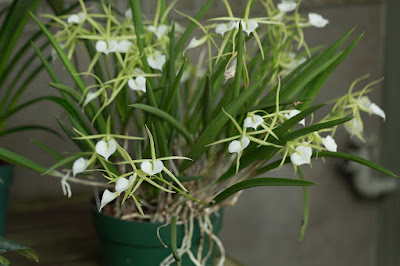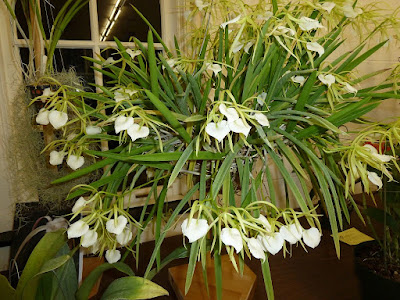Brassavola Little Stars s a lovely balance of the parents: it has larger flowers, like B. nodosa, and a higher flower count, like B. subulifolia.
Brassavola Little Stars, also called as Little Stars Brassavola, is a hybrid in the genus Brassavola. This hybrid was made and registered by Ernest Hetherington of Stewart Orchids in 1983.
DESCRIPTION OF BRASSAVOLA LITTLE STARS
Brassavola Little Stars is a cross between Brassavola nodosa as seed parent Brassavola subulifolia as female parent. It is a popular orchid with collectors. It is a lovely balance of the parents: it has larger flowers, like Brassavola nodosa, and a higher flower count, like Brassavola subulifolia.
It is a medium sized, hot growing epiphyte or lithophyte, which can reach a height of 38-46 cm, with cylindrical, short, up to 15 cm long stems enveloped by scarious sheaths with a single, sub-terete, sulcate, acute-apiculate, 10-30 cm long and 0.3-1.8 cm wide leaf.
Little Stars Brassavola can blooms multiple times a year, at just about any time, from the 20 cm long, bracteate inflorescence that arises on a newly maturing pseudobulb with bout 6 flowers per a spike. The flowers are similar to Brassavola nodosa and has a very aromatic fragrance at night, something like vanilla and cloves.
BRASSAVOLA LITTLE STARS CARE AND CULTURE
Cultural information should only be used as a guide, and should be to be adapted to suit you. Your physical location; where you grow your plants, how much time you have to devote to their care, and many other factors, will need to be taken into account. Only then can you decide on the cultural methods that best suit you and your plants.
Light:
Brassavola Little Stars needs a light level of 25000-35000 lux. The light should be slightly filtered or dispersed, and the plants should not be exposed to the direct sunlight of the midday sun. Strong air movement should be ensured all the time. The plants can tolerate higher light levels if they get used to it gradually. When the light intensity is higher, there must be high humidity and a lot of air movement. To avoid burns, you should also make sure that no water is left on the leaves during the strongest sunlight.
Temperature:
In summer, the average day temperature is 28-30 °C, night 22-24 °C, with a daily amplitude of 6-8 °C. The average winter temperature is 24-26 °C at day, 17-18 °C at night, with a daily amplitude of 6-8 °C.
Humidity:
Little Stars Brassavola needs the humidity of 75-80% throughout the year. Too dry air has a negative effect on the development of the plant: its growth is inhibited, and the leaves begin to turn yellow and dry out. The higher temperature, the higher the humidity should be, and the higher the humidity, the more often and longer it is necessary to ventilate the room where the plants are contained, otherwise the probability of rotting and various kinds of fungal diseases. Good air movement is essential while the plants are in leaf and growing.
Substrate, growing media and repotting:
Brassavola Little Stars grow best mounted on a pad or placed in a hanging basket filled with a very thick, loose, quickly drying ground. These plants grow well attached to pieces of tree fern or cork, but in the summer it requires high humidity and daily watering. In the period of extremely hot and dry weather, the plants may require even several waterings during the day.
The plants can also be grown in plastic pots. High watering requirements during the growing season require the use of a very loose, well-drained substrate, e.g. pine bark, pieces of cork or tree fern fibers, with medium or large gradation. Use small pots so that only the roots can fit and there is room for about two years of growth.
Repotting or dividing the plant should be done only when the growth of new roots begins. The plant slowly returns to full strength after frequent divisions and the plants are much healthier and more vital if instead of repotting it will translate them into a larger container with good drainage, assuming that the substrate has not been decomposed.
Watering:
Little Stars Brassavola should be watered strongly during the period of active growth, but the roots must always dry quickly after watering. Watering every 2-3 days during the hottest and brightest periods of the year is compatible with most natural habitats. In late autumn, watering should be limited.
Fertilizer:
The plants should be fertilized every week 1/4-1/2 of the recommended dose of fertilizer for orchids. A fertilizer with a high nitrogen content is beneficial from spring to mid-summer, and a fertilizer richer in phosphorus should be used in late summer and autumn. This improves flowering in the following season and strengthens new growths before winter. The substrate should be flushed every few weeks to avoid the formation of mineral deposits, especially when large doses of fertilizers have been applied. First, water the plants as normal to dissolve the accumulated salts. After about an hour, the substrate should be rinsed with twice the amount of water. Annual flushing is important especially where the water is highly mineralized.
Rest period:
Brassavola Little Stars need a rest period in winter. In this period, the amount of water should be reduced. However, you must not let the plants stay dry for a long time. In most cases, such conditions can be ensured by morning misting combined with very light watering every 2-3 weeks, especially when sunny weather is expected. It is important to ensure a dry resting period when new increments reach maturity. If the plants are grown in dark conditions, short day, which occurs in moderate latitudes, it is easiest to provide such a dry rest period in the winter. Fertilization should be reduced or completely eliminated until more intense watering starts in the spring.















COMMENTS